The “Indestructible” Plant for Everyone
Are you an aspiring plant parent or trying to make your indoor or office space a little greener? But you do not know where to start, or you feel like you don’t seem to have a green thumb? Snake plants are the ideal starter pack for beginner plant parents!
Snake plants (widely known scientifically as Sansevieria) are now placed in the genus Dracaena of the Asparagaceae Family. Here’s why. These plants with their thick, fleshy leaves that resemble flames and sharp pointy ends are super resilient and are known to thrive on neglect. Other common names include ‘Mother-in-law’s Tongue’, ‘St. George’s Sword’ and ‘Lidah Jin’ in Malay.
Just having plants around and caring for them boosts mental health. Snake plants are no exception to the rule. They are excellent air purifiers, cleansing the air of formaldehyde, xylene, benzene, toluene, and trichloroethylene and of course carbon dioxide. An interesting feature of Snake Plants is that unlike other plants that drastically reduce their rate of photosynthesis during the night, snake plants continue to produce oxygen even at night. This unique feature makes this plant ideal for indoor spaces and bedroom decorations to improve air quality. However, this quality causes the plant to be toxic if ingested and you have to be extra careful if you have gastronomically curious young children or pets.
Snake Plants require minimal attention. You can keep them in a dimly lit space, in a bright indoor space or even under full sun and they would strive in any condition. Water them only when necessary, or if you’re not sure – only when the soil is completely dry. Fertiliser is not needed, but if you absolutely want to, you can feed them twice a year.
Mother Snake Plants produce offsets or ‘pups’ by underground rhizomes. So if you keep them in a pot, they will eventually form compact rosettes of new plants. and if you plant them in the ground, they would create more clumps of the species in your garden. They also can be propagated by their leaves. Just cut a leaf from the mother plant, trim the bottom of said leaf and place it in a glass of water. Eventually, the leaf will root and produce a new snake plant. And if you are impatient, you can add a tiny bit of rooting powder to the water to promote faster root emergence.
Here are some examples of Snake Plants that we recommend:
1. Dracaena trifasciata ‘Bantel’s Sensation’
This cultivar of the snake plant is slender with white stripes running along its long leaves which can reach a meter in height. The leaves which are almost completely vertical makes it an ideal species to be used in minimalist interior designing and for people who want long shapes and sharp edges in their designs.
Image source:
https://thursd.com/articles/the-foolproof-sansevieria-bantels-sensation
2. Dracaena trifasciata ‘Black Coral’
This variety has dark green leaves, with wide light-green, greyish horizontal stripes, with the patterns oscillating very much like the tracing of the electrical pulses of a heartbeat in an ECG (electrocardiograph).
Image source:
https://www.plumetismagazine.net/sansevieria-plante-graphique/
3. Dracaena trifasciata ‘Black Diamond’
The black diamond has wide, dark glossy leaves, occasionally with a narrow yellow streak at its margins. These pointy plants would look like stagnant, green flames in the spaces you keep them.
Image source:
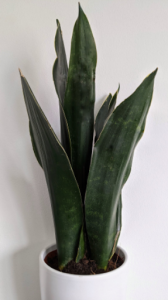
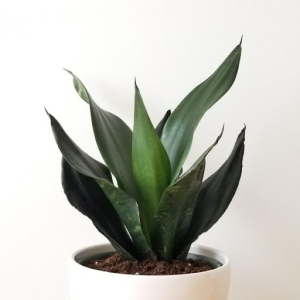
4. Dracaena trifasciata ‘Black Dragon’
This short variety produces dark green glossy leaves which makes it perfect for office or café table-tops, coffee tables at home or even plant it in the ground in your garden. This variety is similar to ‘Black Diamond’ but is a smaller version and it doesn’t have a narrow yellow margin.
Image source:
5. Dracaena trifasciata ‘Black Gold’
This variety produces dark, almost black leaves with a striking band of yellow along their margins. Their greyish-silvery vertical bands are visible if you look closely. The plant’s sleek look makes it great for indoor working spaces that require a splash of colour.
Image source:


6. Dracaena trifasciata ‘Gold Flame’
This interesting variety forms short clumps of dark green leaves. However, new leaves that are produced are completely gold or yellow slowly turning green as they mature. This gives the plant an illusion of a bright glow emanating from the center of the plant.
Image source:
7. Dracaena trifasciata ‘Hahnii’
This cultivar produces packed, short stubby rosettes that earned it the common name: Bird’s Nest Snake Plant or Dwarf Snake Plant. Because of its small stature, it’s ideal for table tops, or gifts to friends who are beginner plant parents. If you’re really adventurous, you could even incorporate this small rosette of a snake plant into your bouquet design!
Dracaena trifasciata ‘Golden Hahnii’ is the variegated version of this cultivar.
Image sources:
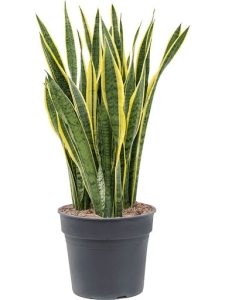
8. Dracaena trifasciata “Laurentii”
Also called the Variegated Snake Plant, this is probably one of the most common Snake Plants that you might have seen. This variety produces long slender leaves that can grow more than a meter in height.
Image source:
9. Dracaena trifasciata ‘Moonshine’
The “Moonshine” is an elegant cultivar desired for its silverish-green leaves which grow wide. This plant gives a ‘clean and polished’ look to any space it is placed in which is great for professional spaces and designs which incorporate minimalism or modernism as it adds a tinge of colour. The leaves however, would get darker if left in a dimly lit environment.
Image source:

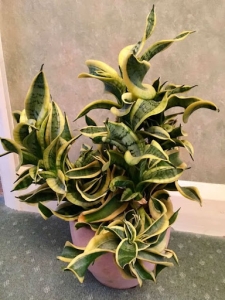
10. Dracaena trifasciata ‘Twisted Sister’
Also known as the Golden Twist Sansevieria, the dimensions of the plant look somewhat like an in-between of the ‘Golden Hahnii’ and ‘Laurentii’ but with a twist, literally. Looking a little eccentric, this variety is perfect for spaces which have funky and unique designs.
Image source:
11. Dracaena trifasciata ‘Whitney’
The ‘Whitney’ is a small to medium sized cultivar which has wide, dark, glossy leaves with only their margins resembling the ‘Black Coral’ variety.
Image source:
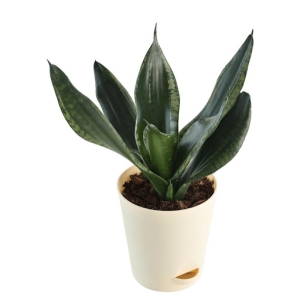
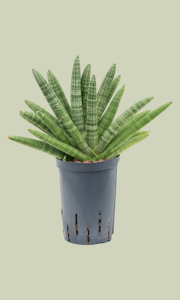
12. Dracaena angolensis
Formerly known as Sansevieria cylindrica, this species is also known commonly as ‘African Spear’, or ‘Cylindrical Snake Plant.’ This species originates from Angola, hence the botanical name. Its stiff, cylindrical leaves grow in a fan-shaped manner, and can possibly grow up to 2 meters off the ground. You probably might have seen this species being sold in stores and nurseries with their leaves braided tightly.
Image source:
13. Dracaena arborescens
Native to Kenya and Tanzania, this species looks like a squat little maize plant with thinner and tougher leaves.
Image source:
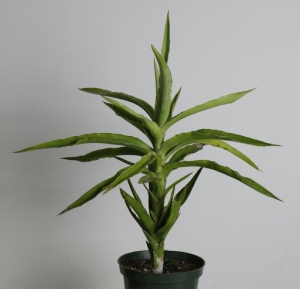
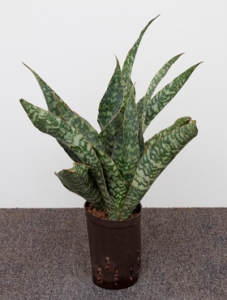
14. Dracaena aubrytiana
This species has relatively wide leaves with wide grey-silverish horizontal stripes. Interestingly this particular species of Snake Plant is also known as “Father-in-law’s Tongue.”
Image source:
15. Dracaena ballyi
This variety is also called Dwarf Snake Plant (not to be confused with D. trifasciata ‘Hahnii’). The edges of their leaves curve inwards, giving them a cylindrical look. The leaves have red-brown apexes (leaf tips), and grow up to 5 to 10cm in length (2 – 4 inches).
Image source:
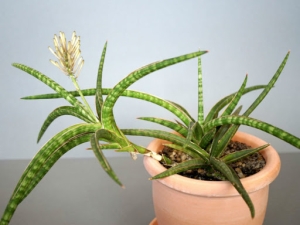
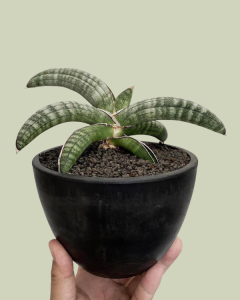
16. Dracaena eilensis
The leaves of this slow-growing species are light green with bands of white marking the length of the leaves. This species has leaf edges which curve inwards as well, creating cylindrical leaves. They also have lines running along the leaves that mark the part of the leaf that will fold in when it lacks water. The leaves fan downwards as more leaves are produced and would be a unique choice of decor due to its banana-shaped, cylindrical leaves.
Image source:
17. Dracaena francisii
This species sports rows of densely packed leaves arranged spirally around its stem. Unlike most other Snake Plants that seem to form leaves near the ground, the leaves of this species grow progressively and visibly further from the ground up. Excellent for decor if you have an affinity for a spiky vibe.
Image source:

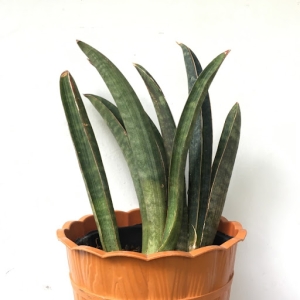
18. Dracaena hallii
This species is often referred to as “Baseball Bat” because the new leaves resemble a baseball bat (up for debate, we reckon). The leaves are thick and almost cylindrical with a shallow groove on the upper side of the leaves. A thin red line marks the margins of the leaves. Unlike most Snake Plants, the flowers of the species form close to the ground. Relatively rare and one of the slow growing species of Snake Plants, this would be a satisfying addition to your collection.
Image source:
19. Dracaena hanningtonii
Its former scientific name – Sansevieria ehrenbergii or S. rorida – being more popular and still widely used, this plant has a similar growth form to that of D. angolensis. The leaves are arranged in two rows opposite each other forming a fan-shape. The leaves are thick and have a thin reddish brown line running along its margins. The apexes are tapered into a hard, sharp point. Commonly they’re called Samurai Sansevieria, Samurai Dwarf Snake Plant, Sword Sansevieria or Blue Sansevieria.
Image source:
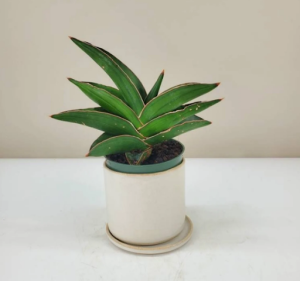
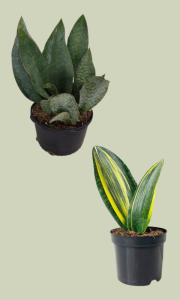
20. Dracaena masoniana
One of the more common Snake Plant species around, this species sports big, wide leaves which have a blueish-green hue. They have the typical horizontal wiggly markings of a snake plant, giving it a mottled-looking pattern from afar. Common names include Whale Fin Snake Plant and Mason’s Congo Snake Plant. Depicted are both the original species and the variegated version.
Image sources:
21. Dracaena parva
This species looks like a clump of grass, but with much thicker, wider and tougher leaf blades. Also known as “Kenya Hyacinth,” this species is one of the few snake plants that would look good in a hanging planter.
Image source:
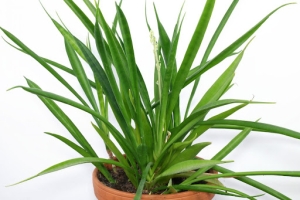
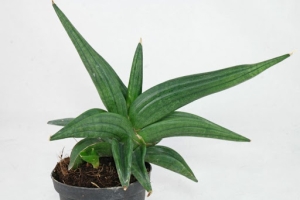
22. Dracaena patens
This species produces leaves that can grow quite long and thick. It is similar to D. angolensis, but the leaves are not as erect and instead of growing into a fan shape, they grow in various directions giving it a unique natural architecture.
Image source:
23. Dracaena pethera
Commonly known as “Star Sansevieria,” and formerly known as Sansevieria kirkii, this beautiful small species has undulating (wavy) leaves. The more striking variety is D. pethera var. pulchra “coppertone,” which has a coppery colour (as shown above).
Image source:
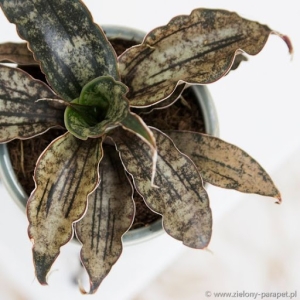
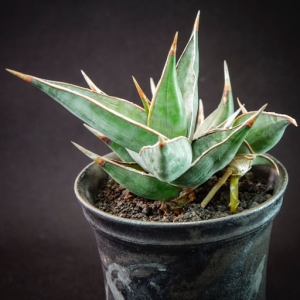
24. Dracaena pinguicula
Resembling a dwarf agave, this species is set apart from the rest of Snake Plants due to its growth habit. Unlike most Snake Plants that grow new pups from underground rhizomes or “runner,” this species produces aerial stolons (runner) which terminate in new plants. These new pups grow roots that reach to the ground, giving the illusion of the new babies walking away from its mother. Hence the common-name: “Walking Sansevieria.”
Image source:
25. Dracaena serpenta
More popularly known by its former botanical name, Sansevieria gracilis, this species has long leaves that curve in various directions making it suitable for hanging planters.
Image source:
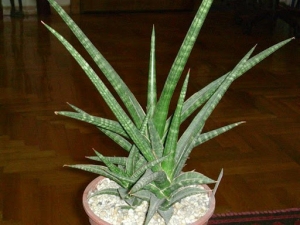
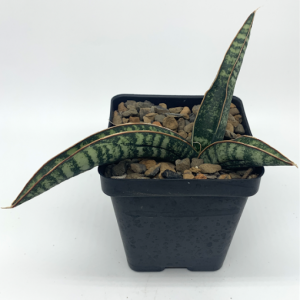
26. Dracena singularis
Previously known as Sansevieria fisheri, this species has thick, dark leaves with the typical horizontal markings with a narrow red-brown marking along their margins.
Image source:
27. Dracaena zebra
Resembling D. trifasciata ‘Bantel’s Sensation,’ but with wider, more undulating leaves, this species is relatively rare. They sport pale, silvery-green leaves and would make elegant additions to your indoor spaces. This species was previously known as Sansevieria metallica.
Image source:

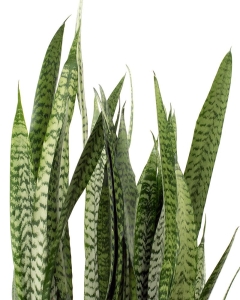
28. Dracaena zeylanica
This species resembles D. trifasciata ‘Black Coral,’ and it is quite difficult to distinguish. It is quite common and many even refer to it as Sansevieria trifasciata zeylanica, a name that does not exist botanically. The name ‘zeylanica,’ refers to its land of origin: Ceylon (now Sri Lanka). It is also commonly known as Ceylon Bowstring Hemp because the plant’s fibers are strong enough that they were used to make bowstrings.
Image source:
https://www.houseofplants.co.uk/
products/sansevieria-zeylanica
29. Dracaena ‘Cleopatra’
This cultivar is a slow-growing hybrid with undulating leaves and intricate markings. Its small stature and pretty natural design would be great for table-top decor.
Image source:

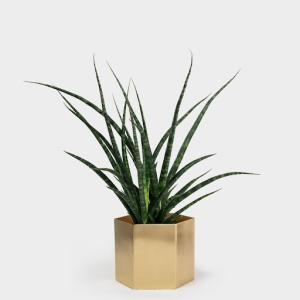
30. Dracaena ‘Fernwood’
This hybrid sports long, grass-looking leaves with tiger stripes. Its ruffled appearance might not give a sleek and elegant vibe to your office space but it is perfect for rustic and hipster places and even designs that incorporate more earthy and wooden interiors.
Image source:
31. Dracaena ‘Star Canary’
Somewhat similar to D. trifasciata ‘Gold Flame,’ this cultivar’s new leaves are a striking yellow-gold, slowly turning to green as they mature. However, unlike ‘Gold Flame,’ this hybrid has a small stature with undulating leaves.
Image source:
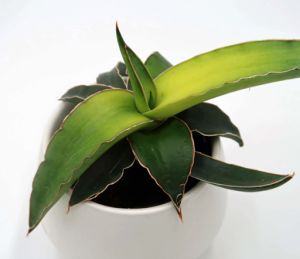
So, as you see, Snake Plants come in numerous cultivars, hybrids and species. So as beginner plant parents, take these as suggestions for the beginning of your plant journey. And for seasoned gardeners, why not try and collect them all?
References:
- https://thursd.com/articles/the-foolproof-sansevieria-bantels-sensation
- https://www.gardenia.net/plant/sansevieria-trifasciata-var-laurentii
- https://en.wikipedia.org/wiki/Dracaena_angolensis
- https://www.epicgardening.com/sansevieria-ballyi/
- https://plantingman.com/sansevieria-eilensis-succulent-plants/
- https://snakeplantcare.com/sansevieria-francisii/
- https://www.smgrowers.com/products/plants/plantdisplay.asp?plant_id=4146
- https://snakeplantcare.com/sansevieria-hallii/
- https://thebelmontrooster.com/families-of-familiar-plants/asparagaceae-family/dracaena-hanningtonii-syn-sansevieria-ehrenbergii-samurai-samurai-dwarf/
- https://www.epicgardening.com/sansevieria-kirkii/
- https://en.wikipedia.org/wiki/Dracaena_pinguicula




